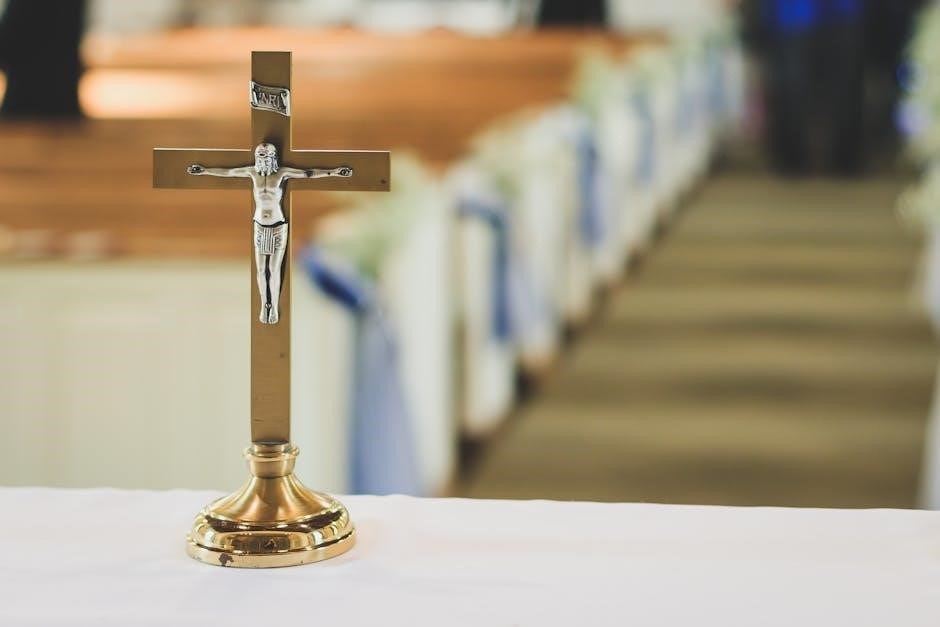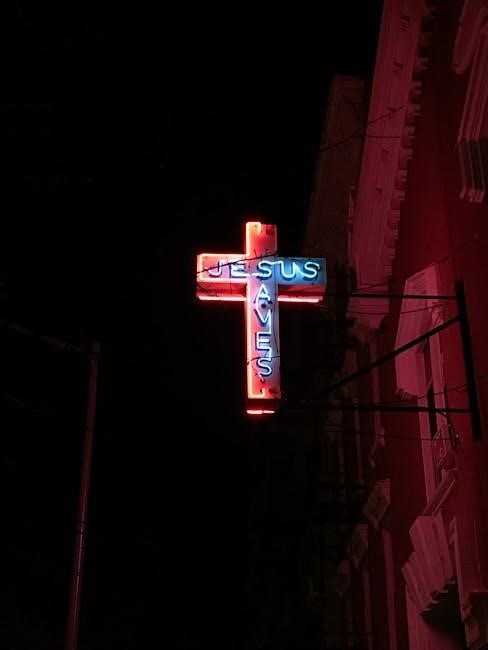Chapter 7 of Lord of the Flies explores themes of fear, leadership, and savagery as the boys’ behavior becomes increasingly primal. The pig hunt symbolizes their descent into chaos, while the conch shell’s fading importance highlights the erosion of order. Ralph’s internal conflict and the group’s distraction by the “Beast” reveal their growing instability and the blurring of civilization and savagery.
Overview of Chapter 7

Chapter 7, titled “Shadows and Tall Trees,” marks a significant shift in the boys’ behavior and mindset. The chapter opens with Ralph reflecting on the group’s deteriorating state, highlighting his growing frustration and isolation. The boys’ fear of the “Beast” intensifies, leading to chaotic behavior and further division. Ralph’s leadership is challenged as Jack’s desire for power grows. The chapter introduces the pig hunt, a pivotal event symbolizing the boys’ descent into savagery. Ralph’s physical changes and longing for home underscore his internal struggle. Simon’s attempts to console Ralph and the group’s distraction by the “Beast” reveal their deepening fear and instability, foreshadowing darker events ahead.
Key Themes in Chapter 7
Chapter 7 delves into fear, leadership struggles, and the erosion of civilization. The boys’ escalating fear of the “Beast” symbolizes their collective anxiety and irrationality; Ralph’s internal conflict highlights his diminishing hope and growing isolation. The pig hunt represents savagery and primal instincts, contrasting with Ralph’s desire for order. Leadership is contested as Jack’s influence grows, challenging Ralph’s authority. Civilization vs. savagery is a central theme, with the conch shell’s diminishing importance reflecting the boys’ regression. Simon’s attempt to console Ralph underscores empathy’s struggle against fear. The chapter emphasizes how fear and power struggles lead to societal collapse, revealing humanity’s darker tendencies.

Questions and Answers from Chapter 7
Explore key questions and answers from Chapter 7, delving into themes like Ralph’s feelings, the pig hunt, and the boys’ fears, providing insights into their evolving dynamics.
How does Ralph feel about the rest of the boys as Chapter 7 opens?
Ralph feels frustrated and isolated as Chapter 7 begins. He is disheartened by the boys’ increasing savagery and their fixation on the Beast, which distracts them from building shelters and maintaining the signal fire. Ralph struggles with the weight of leadership, feeling abandoned by the others as they prioritize hunting and games over survival priorities. His growing sense of despair reflects his realization that the group is slipping further away from civilization. Ralph’s internal conflict highlights his longing for order and maturity, which contrasts sharply with the boys’ descending behavior.
What does Ralph daydream about his home?
Ralph daydreams about the comforts and normalcy of his home, reflecting on his life before the island. He misses his family, the familiar surroundings, and the sense of security that home provides. Ralph’s thoughts drift to simpler times, away from the chaos and responsibilities of leadership on the island. His longing for home underscores his growing frustration with the boys’ behavior and the increasing savagery around him. These daydreams serve as a coping mechanism, offering Ralph a temporary escape from the harsh realities of their stranded existence and the challenges of maintaining order among the group.
Describe the physical changes Ralph notices about himself.
Ralph notices that his clothes are dirty and torn, and his hair has grown long. He feels the weight of his appearance, reflecting on how different he looks compared to his life before the island. Ralph also observes the dirt and grime that have accumulated on his skin, highlighting his growing awareness of the group’s descent into savagery. These physical changes symbolize the erosion of civilization and the boys’ gradual regression into a more primal state. Ralph’s self-awareness of these changes underscores his internal struggle to maintain order and decency amidst the island’s harsh environment and the group’s declining behavior.
What is the game the boys play in Chapter 7?
In Chapter 7 of Lord of the Flies, the boys engage in a pig hunt, which serves as both a game and a turning point in their behavior. This activity symbolizes their shift from civilized norms to more primal instincts, highlighting their gradual descent into savagery. The pig hunt not only provides entertainment but also reflects their growing fascination with violence and power, marking a significant change in their collective behavior and mindset. Through this game, the boys’ primal urges are unleashed, illustrating the erosion of their innocence and the rise of unchecked instincts.
What distracts the boys from the search for the Beast?
The boys are distracted from their search for the Beast by the excitement of a pig hunt. While on the mission to find the Beast, they stumble upon pig droppings, leading Jack to suggest hunting a pig. This diversion captivates the group, shifting their focus from the mysterious creature to the thrill of the hunt. The pig hunt becomes a symbol of their primal instincts and growing savagery, as they abandon their initial goal and immerse themselves in the chaotic and violent pursuit of the pig. This distraction highlights their decreasing concern for order and their escalating fascination with power and control.
What does Ralph long for when the boys first stop and rest?
Ralph longs for cleanliness and order when the boys first stop and rest. He yearns for a bath to wash away the dirt and grime that has accumulated on his skin and clothes. This desire reflects his inner struggle to maintain a sense of civilization and normalcy in the increasingly chaotic environment of the island. Ralph’s longing for cleanliness symbolizes his clinging to the comforts and routines of home, which are rapidly fading as the boys’ behavior becomes more savage and primal. This moment highlights Ralph’s internal conflict between maintaining order and succumbing to the island’s wilderness.
What does Simon say to Ralph to console him?
S Simon consoles Ralph by acknowledging his struggles and offering empathy. He tells Ralph that he understands the weight of leadership and the challenges he faces in keeping the group together. Simon reassures Ralph that he is doing his best and that his efforts are recognized and appreciated. He also reminds Ralph of the importance of maintaining hope and their shared humanity, encouraging him to stay strong despite the difficulties they are encountering on the island. Simon’s words provide Ralph with the emotional support he needs during this stressful time, helping to alleviate his feelings of isolation and doubt.
How does Ralph react when a boar charges down the path?
Ralph reacts bravely when a boar charges down the path during the hunt. Despite his fear, he quickly throws his wooden spear, managing to strike the boar. However, the spear does not stop the boar, and it continues its charge. Ralph’s action demonstrates his courage and willingness to defend himself, even in the face of danger. The incident highlights the primal instincts and adrenaline-driven behavior of the boys as they engage in the hunt, further emphasizing the theme of savagery emerging on the island. Ralph’s reaction also showcases his leadership qualities, as he takes initiative in a high-pressure situation.
What does the pig hunt symbolize in the chapter?
The pig hunt in Chapter 7 symbolizes the boys’ descent into savagery and primal instincts. It represents their growing disconnect from civilization and the embrace of raw, instinctual behavior. The hunt becomes a ritual, reflecting their excitement and bloodlust as they abandon reason and order. This event highlights the internal conflict between humanity and savagery, as the boys’ actions become more violent and less restrained. The pig hunt also foreshadows the complete breakdown of their civilized norms and the rise of chaos on the island. It serves as a pivotal moment in their transformation from innocent children to primal hunters.
What does the Lord of the Flies represent?
The Lord of the Flies represents the embodiment of evil and the primal savagery within humans. It symbolizes the beast the boys fear and their own inner darkness. As a severed pig’s head impaled on a stake, it serves as a tangible manifestation of their collective fears and the true nature of humanity. The Lord of the Flies also signifies the erosion of innocence and the descent into chaos, highlighting the intrinsic evil that surfaces when societal constraints are removed. It embodies the idea that true evil resides within humans, not in mythical creatures, reflecting Golding’s philosophy on human nature.

Analysis of Key Events in Chapter 7
Chapter 7’s key events reveal the boys’ descent into savagery, highlighted by the chaotic pig hunt and their overwhelming fear of the Beast. Tension rises as Ralph struggles to maintain leadership, and Jack’s desire for power grows, symbolizing the erosion of innocence and civility. The chapter underscores the primal instincts emerging among the group, foreshadowing further conflict and the true nature of humanity.
The Pig Hunt and Its Significance
The pig hunt in Chapter 7 of Lord of the Flies symbolizes the boys’ descent into savagery and their primal instincts. The hunt becomes a chaotic, uncontrollable event, driven by excitement and fear. Ralph, initially hesitant, joins the frenzy, highlighting the loss of rationality. Jack’s aggressive leadership during the hunt underscores his desire for power and control. This event marks a turning point, as the boys’ behavior becomes more violent and tribal, reflecting the erosion of their civilized norms. The hunt also foreshadows the group’s future conflicts and the inevitable collapse of their fragile society.
Simon’s Conversation with Ralph
Simon’s conversation with Ralph in Chapter 7 highlights Simon’s empathetic nature and his understanding of Ralph’s struggles. Simon consoles Ralph by acknowledging his leadership burdens and the growing fear of the “Beast.” Ralph expresses frustration over the boys’ behavior and the fading importance of the conch shell. Simon’s calm demeanor contrasts with the chaos around them, showcasing his wisdom. Their dialogue underscores the tension between Ralph’s desire for order and the group’s descent into savagery. Simon’s words offer temporary comfort but also reveal the deeper fears and uncertainties plaguing the boys, emphasizing the fragility of their civilized facade.
Ralph’s Struggle with Leadership

Ralph’s struggle with leadership in Chapter 7 reflects his growing frustration and helplessness. He feels burdened by the responsibility of maintaining order and fears the boys’ descent into savagery. Ralph’s leadership is challenged by Jack’s defiance and the group’s fixation on the “Beast,” which distracts them from essential tasks like tending the signal fire. Ralph’s internal conflict is evident as he grapples with his desire to lead versus his longing for the simplicity of home. His physical appearance, now disheveled, mirrors his loss of control. The conch shell, once a symbol of authority, begins to lose its power, signaling the erosion of Ralph’s leadership and the decline of civilized behavior among the boys.

Symbols and Themes in Chapter 7
The conch shell symbolizes order, while the Beast represents primal fear. The pig hunt embodies savagery, contrasting with the fading civilization the boys once knew.
The Conch Shell as a Symbol of Order
The conch shell, once a powerful symbol of order and democracy, begins to lose its significance in Chapter 7. As the boys’ behavior becomes more chaotic and primal, the conch’s authority fades. Ralph, who once relied on it to maintain control, struggles to keep the group focused. The shell’s diminishing influence reflects the erosion of civilization among the boys, as their fear of the Beast and their excitement over the pig hunt overshadow their commitment to order. This decline marks a turning point, highlighting the tension between savagery and the remnants of their former structured society.
The Beast as a Representation of Fear
The Beast embodies the collective fear of the boys, symbolizing their deep-seated anxieties about the unknown. In Chapter 7, the Beast becomes a unifying yet divisive force, driving the boys’ actions and decisions. Their fear of the Beast leads to irrational behavior, such as abandoning the search for it and engaging in chaotic activities like the pig hunt. The Beast’s presence creates tension among the group, highlighting their vulnerability and the fragility of their sanity. It serves as a catalyst for their descent into savagery, revealing how fear can manipulate and control individuals, leading to the breakdown of order and rationality.
Civilization vs. Savagery
In Chapter 7, the struggle between civilization and savagery intensifies as the boys’ behavior becomes more primal. The pig hunt symbolizes their descent into savagery, while Ralph’s longing for order and cleanliness reflects his clinging to civilization. The group’s focus on hunting and fear of the Beast overshadows their commitment to maintaining the signal fire, a symbol of their connection to rescue and civilized life. This shift highlights the fragility of civilization when primal instincts and fear take over. The chapter vividly portrays how quickly societal norms can erode, revealing the inherent human tendency toward savagery when structure and accountability fade.

Study Guide and Resources
Access Chapter 7 study guides and PDFs with Q&As online. Digital libraries offer comprehensive analysis and study tips for key events and themes easily.
Where to Find Chapter 7 Questions and Answers PDF
Chapter 7 questions and answers PDFs are available on educational platforms and digital libraries. Websites like Google Books, Scribd, and educational hubs offer free access to study guides. Many universities also provide PDF resources for Lord of the Flies through their online libraries. Search for “Lord of the Flies Chapter 7 questions and answers PDF” to find downloadable materials. These resources often include detailed analyses, study tips, and summaries to aid preparation; Ensure to use reliable sources for accurate and comprehensive content to enhance your understanding of the chapter.
Study Tips for Understanding Chapter 7
To effectively study Chapter 7 of Lord of the Flies, focus on key themes like fear, leadership, and savagery. Analyze symbols such as the conch shell and the pig hunt to understand their significance. Review the physical and emotional changes in Ralph to grasp his character development. Discuss the chapter’s events, like the boys’ distraction by the “Beast,” to explore how fear drives their actions. Use PDF study guides to practice answering questions and identify motifs. Engage in group discussions to gain diverse perspectives. Finally, create a study schedule to ensure thorough preparation for exams or quizzes.
